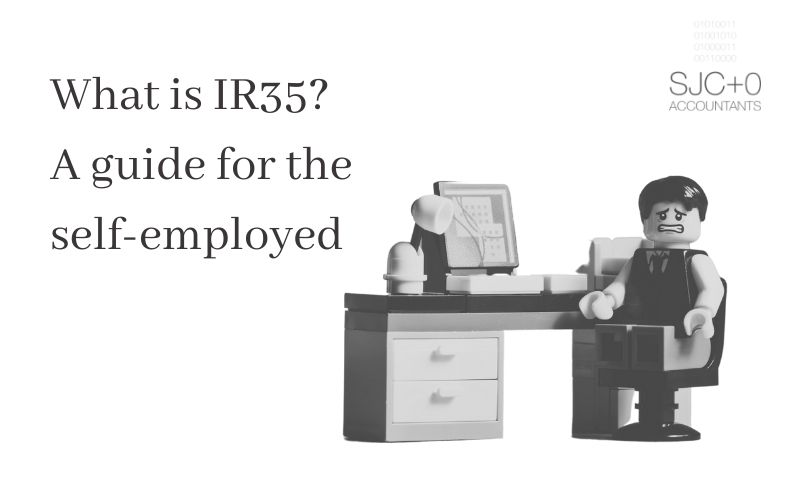A quick IR35 definition – and why IR35 exists
IR35 is another name for the off payroll working rules. It’s designed to assess whether a contractor is a genuine contractor rather than a ‘disguised’ employee, for the purposes of paying tax.
Contractors who work through their limited company enjoy a level of tax efficiency. While they don’t usually get employee benefits (like holiday and sick pay), they have flexibility and control over their work.
Some contractors and their clients try to take advantage of this tax efficiency by working as if they’re self-employed, when for all intents and purposes they’re employees. HMRC has designed the off-payroll working rules to tackle this – but the rules aren’t without their problems.
IR35’s nuances mean that contractors can’t be expected to know the law inside out. Please only use this article as a guide – if you’re unsure about anything, then book a call with me.
IR35 helps HMRC tackle tax avoidance through off-payroll working
HMRC introduced IR35 (or the ‘off-payroll working rules’) in 2000 to tackle what it calls ‘disguised’ employment.
When a contractor is a ‘disguised’ employee, they might be taking advantage of the tax efficiency of working through a limited company, when they’d really be an employee were they not working through their company.
The benefit for employers is that they don’t have to pay employers’ National Insurance contributions or give contractors employee benefits.
The benefit for contractors is that they can pay themselves tax efficiently.
So IR35 is essentially an employment status test for tax, which works out whether a contract points towards employment or self-employment:
- if your contract is inside IR35, it points towards employment. HMRC sees you as an employee and you face an income tax and National Insurance burden, just as employees do
- if your contract is outside IR35, it points towards self-employment, and you can enjoy the tax efficiency that self-employment brings (as well as all the associated risks)
But IR35 rules are complicated (and controversial)
Many find the legislation complicated to understand. Even HMRC seems to struggle – its record on fighting IR35 cases at tribunal is patchy.
In 2019, TV presenters Kaye Adams and Lorraine Kelly successfully challenged HMRC in separate cases, proving that they weren’t inside the rules.
A lack of clarity, along with ambiguity over employment status guidelines (including available employment rights if contractors are found inside IR35), has been controversial.
How IR35 rules work in practice
When does IR35 apply?
HMRC says that when working out whether IR35 applies to a contract or engagement, “you must work out the employment status of the person providing their services.”
HMRC goes on to say that the off-payroll rules apply if the contractor “would be an employee if there was no intermediary”. The intermediary in many cases is the contractor’s limited company (often called a personal service company).
Intermediary meaning: what is an intermediary?
IR35 is also known as the ‘intermediaries’ legislation’ because it applies to workers who provide their services through an intermediary, rather than working as an employee.
As mentioned, the intermediary will often be the contractor’s own limited company, or personal service company.
A personal service company is a limited company where the sole director, the contractor, owns most or all of the shares. The contractor then delivers services to clients.
- a partnership
- another personal service company
- an individual
A contractor can provide their services directly to clients through their intermediary, or they might work through an agency or umbrella company.
What does IR35 status depend on?
IR35 status tests usually relate to supervision, direction and control. I’ll go into more detail as part of the IR35 checklist below.
HMRC also has a tool called CEST (check employment status for tax) you can use to check whether IR35 applies to a contract, plus an IR35 helpline.
In reality, IR35 status hinges on IR35 case law and employment legislation, itself reliant on decades worth of employment tests heard in UK courts.
Another problem is that CEST may not be 100% accurate, as it doesn’t take a key piece of case law (mutuality of obligation or MOO) into account.
Who works out IR35 status?
There are currently different rules for public sector and private sector contracts.
Off-payroll working rules in the public sector
- the hirer is responsible for working out whether the contractor falls inside or outside of IR35. If they fall inside, the hirer, agency or other third party who pays the contractor then needs to deduct tax and NICs and report them to HMRC
Off-payroll working rules in the private sector
- the contractor is responsible for working out whether they fall inside or outside of IR35. If they’re inside, they need to pay the tax and NICs due
This is set to change from April 2021.
What are the IR35 changes?
Private sector IR 35 reform is set for April 2021, when the public sector off-payroll working rules will be applied to the private sector.
This was meant to happen in April 2020, but it was delayed by a year because of coronavirus.
The upcoming IR35 changes mean that:
- medium-sized and large businesses will be responsible for working out the contractor’s employment status, not the contractor
- contractors should be given the reasons behind the decision in a Status Determination Statement, and can dispute the decision if they disagree with it
- small businesses are exempt from the changes – if a contractor works for a small client, the contractor will still be responsible for working out their employment status
End clients are classed as small businesses if they meet two of the following criteria, for two consecutive financial years:
- annual turnover of no more than £10.2 million
- balance sheet total of no more than £5.1 million
- no more than 50 employees
End clients need to show they’ve taken reasonable care when working out IR35 status. If they haven’t, HMRC will hold them responsible for getting things wrong.
Businesses and contractors should prepare for the 2021 IR35 changes.
The IR35 checklist below can help you get IR35 compliant.
IR35 checklist: am I compliant?
In general, IR35 won’t apply if the contract is for services rather than employment. To untangle that, you should see whether the contract specifically mentions these principles:
- supervision, direction, control – this relates to how much say your client has over how you complete your work. For example, if you have to work at certain times, this implies employment
- substitution – could you bring someone else in to complete the contract, or do you need to do the work yourself? If you can’t send someone else, you’re likely to be within IR35
- mutuality of obligation (MOO) – is there an obligation on the employer’s end to offer work, and do you have to accept it? This is called mutuality of obligation and if an element of it exists, the contract may fall inside IR35
The contract has to reflect your actual working practices – essentially, the clauses need to be genuine.
Supervision, direction, control
For a contract to fall outside IR35, contractors should have freedom over how they complete their work.
- a contract that specifies things like the time you can start and finish work, or the days you’re required to work, points towards employment
- a contract might also point towards employment if a client oversees your work excessively and gives guidance on how to complete it
- plus, if you’re not only providing your services for the agreed job but also working on different tasks as your client sees fit, the contract is likely to be inside IR35
Substitution
For a contract to fall outside IR35, you should be able to send a substitute to complete the work instead.
- does your client only want you, or services more broadly? An outside IR35 contract might state that someone else can provide their services to complete the work
- the clause has to be genuine – you should know which skilled contractors you would ask
- plus the contract can’t be so restrictive that you essentially need to do the work yourself
Mutuality of obligation (MOO)
This is an important clause in a contract, as it’s a key test when working out self-employed status. If the client is obliged to offer work (and pay you) and you’re obliged to take it, this demonstrates a contract of employment.
- in practice, this means a self-employed contract involves working on a project-by-project basis
- once you’ve completed a project, you’re under no obligation to work on further tasks (and the client is under no obligation to offer them)
- you should also consider whether you can work for other clients simultaneously. If that’s prohibited, it points towards employment
Other factors on your IR35 checklist
There’s more criteria to consider when working out IR35 status:
- equipment – HMRC often tries to argue that if equipment is provided by the client, and you don’t use your own, you’re a disguised employee
- financial risk – self-employed contractors usually take a degree of financial risk, like any other business. Are you responsible for errors made during the contract, and would you need to rectify them in your own time? There’s usually a requirement to have professional indemnity insurance.
- the way you’re paid – self-employed people are paid on a project basis, which might mean when the work is completed or at particular project milestones
- ‘part and parcel’ of the organisation – if contractors become so ingrained that they become part of a company’s structure, with people reporting to them for example, this points to employment rather than self-employment
- exclusivity – do you work for other clients? Typically the self-employed can work for multiple clients at once
- intentions of the parties – the contract should make sure the relationship between contractor and client is one of supplier and customer, but this should be genuine. If HMRC found the actual intended relationship is more like an employee and employer, it’ll ignore the contract
- business ‘on your own account’ – essentially this determines whether you’re actually running your business as a business. If you have things like a business website, a dedicated office space, and even employees, you could be seen as operating a business and not offering your services in the same way as an employee
Make sure you clarify your relationship with the hirer before you start the contract by considering all of these principles.
Again, before you start working, you should seek expert IR35 advice.
If you need help with any of this process, you might want to consider hiring a good accountant. At SJC+0 we aim to create transparent relationships with my clients. I will quote a fee for the work and will stay in touch throughout the year delivering a tailored service, to ensure that tax is minimised and growth maximised.
Let’s Chat
Susan Crichton
SJC+0 Accounts
07957 581757
susan.crichton@sjcplus0.co.uk

